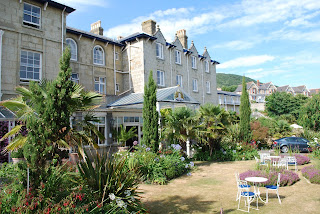Until I was six, I lived on the Isle of Wight, at Belcroft House, Newport. It was built by "a pupil of John Nash". In fact, it wasn't as grand as this sounds, since it had been divided into council flats. We had the ground floor. When we lived there, it had a large conservatory in front. My main memory is being taken up ontothe roof to watch the "Queen Mary" sail down the Solent. I managed to locate the house on a visit many years later.
This summer we returned to the island, staying at the Royal Hotel in Ventnor, close to the southern tip of the island. The hotel had a fine garden.
From the hotel it was only a short walk down the hill to the beach.
A mile or so away we found the Ventnor Botanical Garden; a sub-tropical paradise on the site of an old tuberculosis sanatorium.
The oldest building on the island is Carisbrooke castle. There was a motte here, and a tower (probably made of wood) as early as 1100. The present gatehouse and keep date from the early 14th century, when there were fears of a French invasion.
King Charles I was held a prisoner here after his defeat in the civil war, before being taken to London for trial and execution.
Queen Victoria and Prince Albert loved the island, and built Osborne for their family. It is a vast Italianate mansion with formal gardens, grounds sweeping down to the Solent, and a special house and farming allotments for their children. (I have written about the house on an earlier posting)
After Abert died, Queen Victoria kept his rooms completely untouched. She died at Osborne in 1901.
In the pre-reformed Parliament before 1832, the Isle of Wight was politically significant, since it elected no fewer than six M.P.s: two for Newport, two for Yarmouth, a Henrician fort at the western tip of the island, and two for Newtown, which today consists merely of a small town hall on a desolate marsh.
Friday, 4 January 2019
Subscribe to:
Post Comments (Atom)










No comments:
Post a Comment